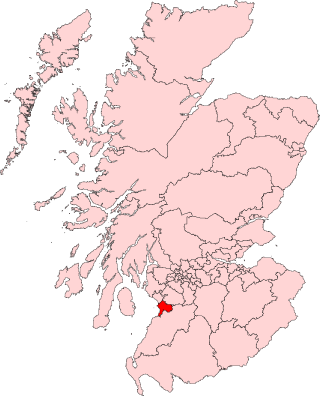
Ayrshire is a historic county and registration county, in south-west Scotland, located on the shores of the Firth of Clyde. The lieutenancy area of Ayrshire and Arran covers the entirety of the historic county as well as the island of Arran, formerly part of the historic county of Buteshire. Its principal towns include Ayr, Kilmarnock and Irvine and it borders the counties of Renfrewshire and Lanarkshire to the north-east, Dumfriesshire to the south-east, and Kirkcudbrightshire and Wigtownshire to the south. Like many other counties of Scotland, it currently has no administrative function, instead being sub-divided into the council areas of East Ayrshire, North Ayrshire and South Ayrshire. It has a population of approximately 366,800.

North Ayrshire is one of 32 council areas in Scotland. The council area borders Inverclyde to the north, Renfrewshire and East Renfrewshire to the northeast, and East Ayrshire and South Ayrshire to the east and south respectively. The local authority is North Ayrshire Council, formed in 1996 with the same boundaries as the district of Cunninghame which existed from 1975 to 1996.

The County of Bute, also known as Buteshire, is a historic county and registration county of Scotland.

Ardrossan is a town on the North Ayrshire coast in southwestern Scotland. The town has a population of 10,670 and forms part of a conurbation with Saltcoats and Stevenston known as the 'Three Towns'. Ardrossan is located on the east shore of the Firth of Clyde.

North Ayrshire and Arran is a constituency of the British House of Commons, located in the south-west of Scotland within the North Ayrshire council area. It elects one Member of Parliament (MP) at least once every five years using the first-past-the-post voting system of voting.

Central Ayrshire is a constituency of the British House of Commons, located in the south-west of Scotland within the North Ayrshire and South Ayrshire council areas. It elects one Member of Parliament (MP) at least once every five years using the first-past-the-post system of voting.

Ayr was a county constituency of the House of Commons of the Parliament of the United Kingdom from 1950 to 2005. It elected one Member of Parliament (MP) by the first-past-the-post system of election.
East Fife was a county constituency represented in the House of Commons of the Parliament of the United Kingdom from 1885 to 1983. Along with West Fife, it was formed by splitting the old Fife constituency.
South Ayrshire was a county constituency of the House of Commons of the Parliament of the United Kingdom from 1868 until 1983, when it was abolished. It returned one Member of Parliament (MP), elected by the first past the post voting system.
Lanark was a county constituency of the House of Commons of the Parliament of the United Kingdom (Westminster) from 1918 to 1983. It elected one Member of Parliament (MP) by the first past the post voting system.
Kilmarnock Burghs was a district of burghs constituency of the House of Commons of the Parliament of the United Kingdom from 1832 to 1918. It elected one Member of Parliament (MP) by the first-past-the-post voting system.
Buteshire was a county constituency of the House of Commons of the Parliament of Great Britain from 1708 to 1801 and of the Parliament of the United Kingdom from 1801 to 1918.
Angus North and Mearns was a county constituency represented in the House of Commons of the Parliament of the United Kingdom from 1950 to 1983. It elected one Member of Parliament (MP) by the first past the post voting system.
NorthLanarkshire was a county constituency of the House of Commons of the Parliament of the United Kingdom (Westminster) from 1868 to 1885 and from 1918 to 1983. It elected one Member of Parliament (MP) by the first past the post voting system.
Ayr Burghs was a district of burghs constituency of the House of Commons of the Parliament of Great Britain from 1708 to 1800 and of the House of Commons of the Parliament of the United Kingdom from 1801 to 1950. It elected one Member of Parliament (MP), using the first-past-the-post voting system.
Kilmarnock was a county constituency of the House of Commons of the Parliament of the United Kingdom from 1918 to 1983. It elected one Member of Parliament (MP) by the first past the post system of election.

Cunninghame North is a constituency of the Scottish Parliament (Holyrood) covering part of the council area of North Ayrshire. It elects one Member of the Scottish Parliament (MSP) by the first past the post method of election. It is also one of ten constituencies in the West Scotland electoral region, which elects seven additional members, in addition to the ten constituency MSPs, to produce a form of proportional representation for the region as a whole.
Peebles and Southern Midlothian was a county constituency of the House of Commons of the Parliament of the United Kingdom (Westminster) from 1918 to 1950. It elected one Member of Parliament (MP) by the first past the post voting system.
North Ayrshire was a county constituency of the House of Commons of the Parliament of the United Kingdom from 1868 until 1918. It returned one Member of Parliament (MP), using the first-past-the-post voting system.









